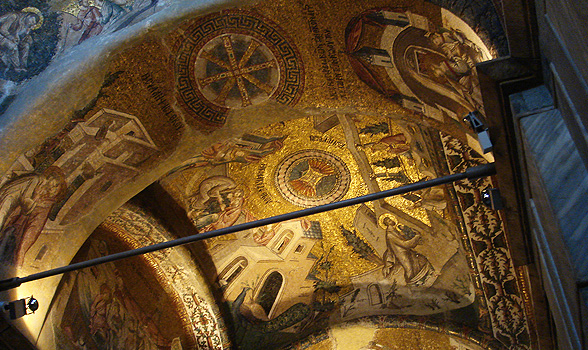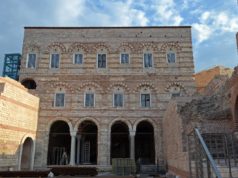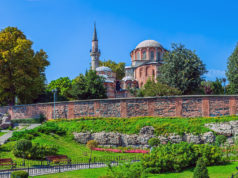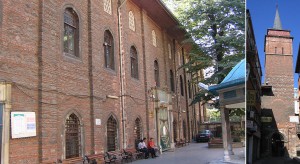
During the XIIth century the emperors of the Comnenus dynasty revived the strength of the Byzantine Empire. After the death of Manuel I in 1180, a series of dynastic quarrels weakened it and led to its temporary end in 1204, when the Crusaders captured Constantinople and established what later on historians called the Latin Empire. This empire was partitioned between the leaders of the crusade and Venice which was rewarded with three eighths of its territory. As a matter of fact some Byzantine families retained control of key towns and provinces such as Trebizond and Nicaea. Venice was not interested in acquiring large land properties and chose to be given islands such as Candia and Negroponte which allowed control of maritime routes; Marco Sanudo, a Venetian adventurer, founded a duchy at Nasso.
Constantinople retains very little evidence of the short-lived Latin Empire (1204-61). We know that a bell tower was built next to Hagia Sophia and a cycle of frescoes portraying the life of St. Francis was painted at Kalenderhane Camii.
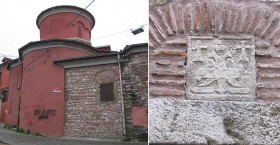
The Genoese reacted to the growing influence of Venice over Constantinople, by strengthening their trading post at Galata on the northern shore of the Golden Horn. The only Gothic church of today’s Constantinople can be found here. It was part of a Dominican monastery built in 1323-37 and it was also known as St. Paul’s owing to a chapel dedicated to that saint. A tall belfry stood next to the church and gave the complex a very western appearance.
In 1261 the territory of the Latin Empire was reduced to just Constantinople, a small part of Thrace and a few fiefdoms in Greece. A small army sent by Michael VIII Palaeologos, the Byzantine ruler of Nicaea, profited from a temporary absence of Baldwin II, the Latin Emperor, and easily managed to enter Constantinople with the help of its Greek population.
The enemy of my enemy is my friend this saying was adopted as a key policy by the new rulers of Constantinople: in order to contain the growing pressure of the Ottomans on their eastern border, they sought an alliance with the Mongol Ilkhanate of Persia, which controlled also parts of Syria and Eastern Anatolia.
In 1265 Emperor Michael VIII betrothed Maria, one of his daughters, to Abaqa Khan. She lived at the Mongol court for fifteen years until the death of her husband. Upon her return to Constantinople she was asked by her father to marry yet another Mongol khan; she preferred to become a nun and retired to a monastery which she renovated; its church was not turned into a mosque by the Ottomans, but the current building bears little resemblance to the original Byzantine church. Its interest lies in its historical background.
The Palaeologos dynasty ruled over a much diminished empire, especially after the loss of Bursa (1326) and Nicaea (1331) to the Ottomans.
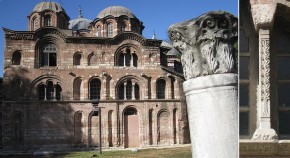
Without an army and a fleet Palaeologos emperors relied only on the walls of Constantinople to keep at bay Bulgarians and Ottomans, Venetians and Genoese.
The best known monument of this period is St. Saviour in Chora, but probably at that time the complex of Theotokos Pammakaristos was regarded as a greater artistic achievement.
Theotokos Pammakaristos is a reference to the Joyous Mother of God; the church was built before the Latin conquest of Jerusalem, but the Parecclesion, a funerary chapel decorated with mosaics and paintings, was added in 1310; this was dedicated to Christos ho Logos (Christ the Word) and a dedicatory inscription runs along its exterior walls.
The complex remained a Christian building for more than a century after the 1453 Ottoman conquest of Constantinople: it was converted into a mosque only in 1591 by Sultan Murad III who called it Fethiye Camii (Mosque of the Victory) to celebrate his campaigns in the Caucasus. Until then it served as the church of the Greek Orthodox Patriarch.
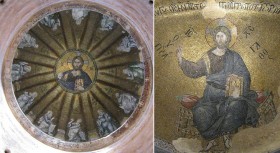
The subject of the decoration is consistent with the Parecclesion dedication to Christ. We know that there were mosaics depicting episodes of his life in addition to portraits in the dome and in the apse: of these only one survived: the Baptism of Christ which can be seen in the picture below. While the main building is still used as a mosque, the Parecclesion is now a museum (apparently with very few visitors, despite being located only a short distance from St. Saviour in Chora). Fanar, the district of Constantinople which used to be its Greek quarter after the Ottoman conquest, is currently the residence of the most religious Muslims of Istanbul; they came from rural regions of central and eastern Anatolia and settled in Fanar in the 1950s when a substantial number of Greeks left the city. They now pray with fervour in mosques which used to be churches and as in the case of Vefa Kilise Camii retain their origin in the name as kilise means church. It was a church dedicated to St. Theodore and it was built making use of material from an earlier building; the tall fluted minaret recalls that of Antalya.
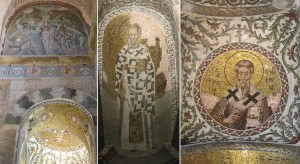
In some instances churches were largely modified when turned into mosques; changes were made to orient them towards Mecca. This is the case of a church which was known as St. Andrew in Krisei; parts of the original building can be detected in the interior but overall it has now a typical Ottoman design.
Koca Mustafa Pacha was for many years Grand Vizier of Sultan Beyazit II. He lost his position and his life in 1512 during a short, but very cruel fight among Beyazit’s sons, who competed for succession.
Ayasma means holy spring and it is not uncommon to find Greek Orthodox churches or other religious establishments near a spring thought to have healing powers. The imperial palace of Blachernae was plundered and almost entirely destroyed after the conquest of Constantinople, but its famous holy spring continues to attract many people and not just Christians. It is not the only holy spring in the city: in addition to that of St. Karalamboy, there is another holy spring outside Silivri Kapi.


